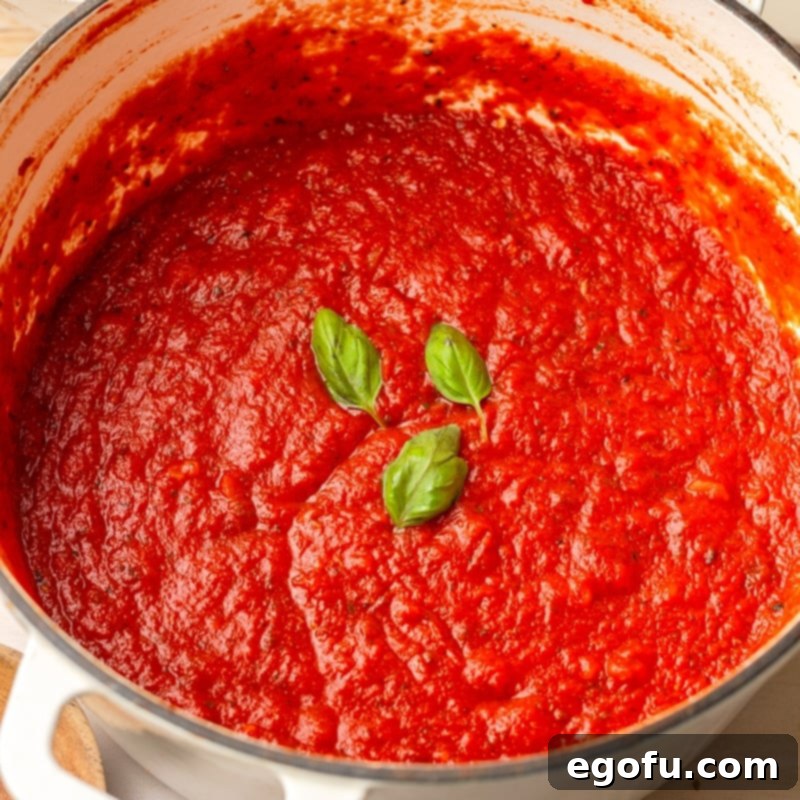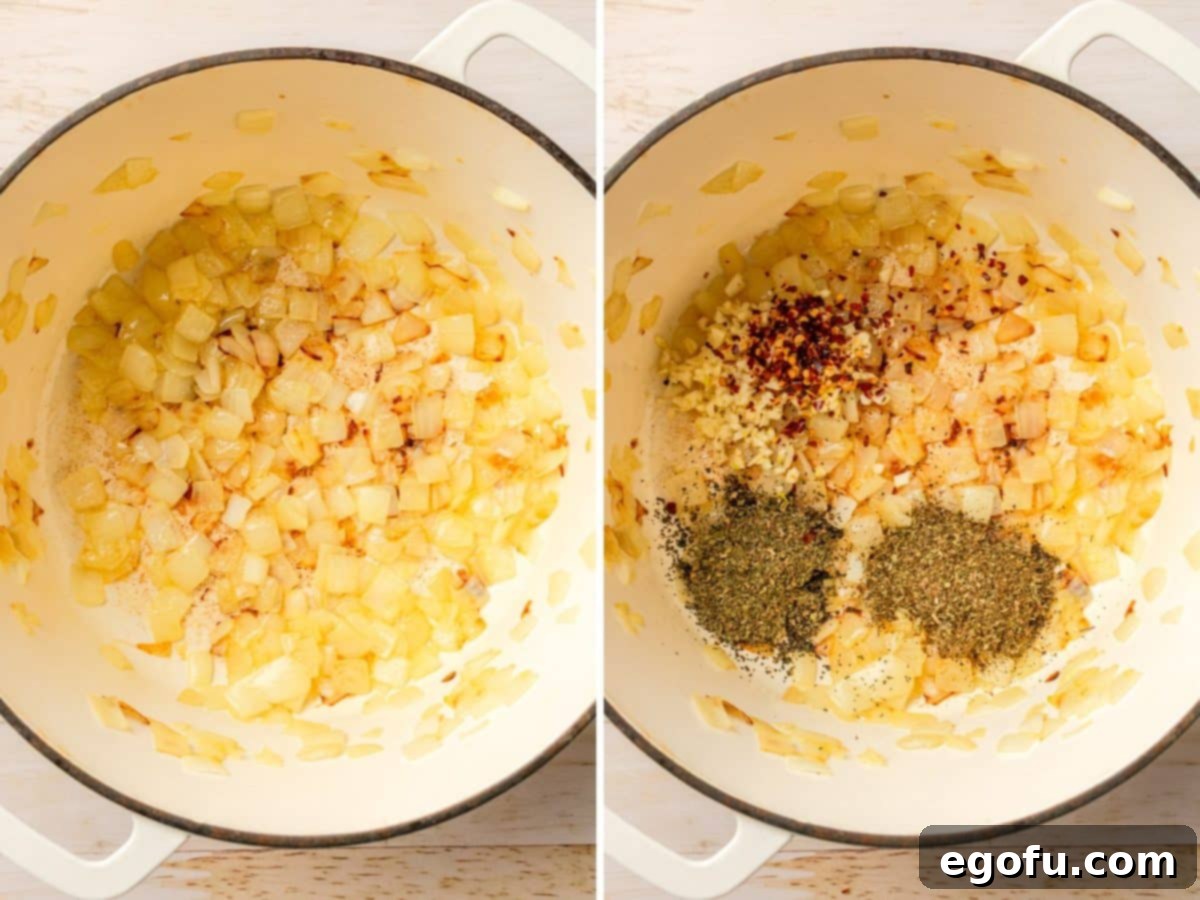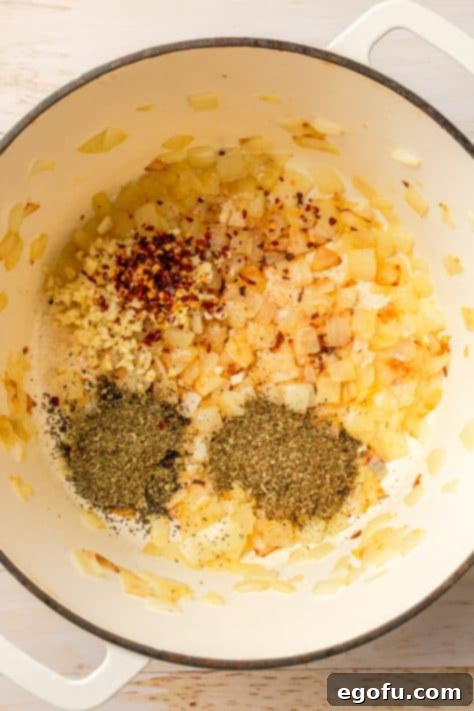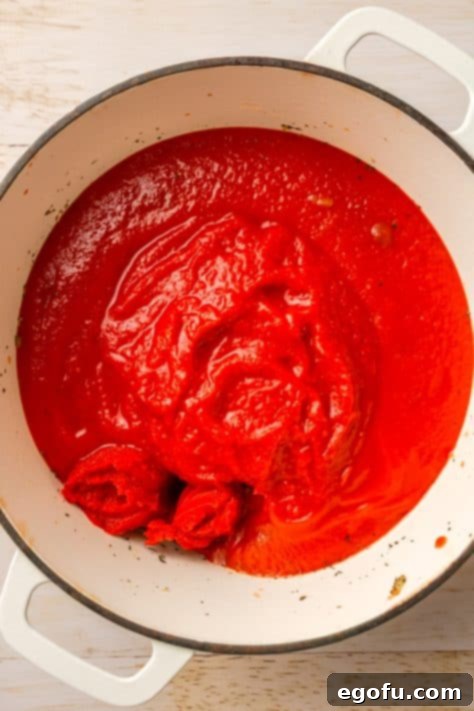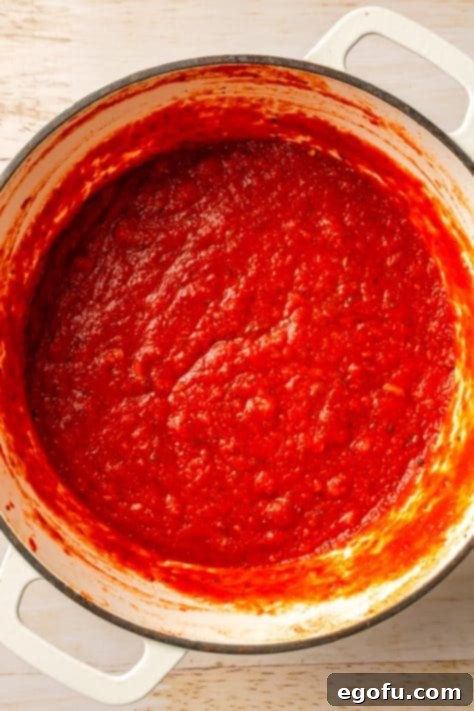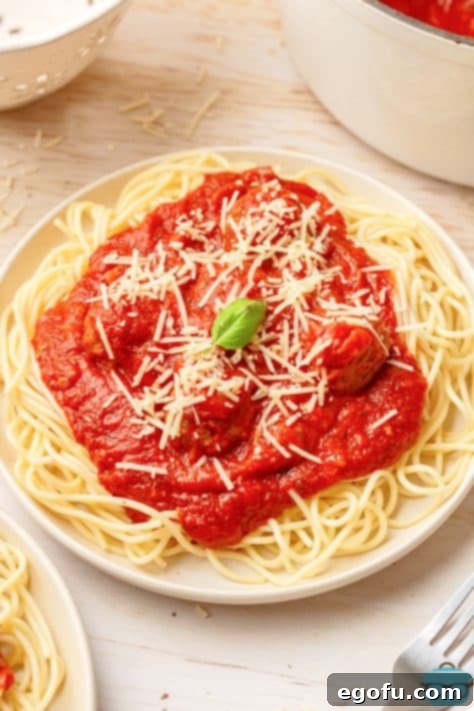The Ultimate Homemade Marinara Sauce: A Flavorful Journey to Italian Comfort
Experience the unparalleled taste of freshly made goodness with this simple yet sublime Homemade Marinara Sauce. Perfectly seasoned and incredibly versatile, this recipe will transform your everyday meals into memorable culinary delights. Forget the jarred alternatives; discover how easy it is to create a rich, robust sauce that’s brimming with authentic flavor – ideal for all your favorite pasta dishes, delectable dipping, and so much more!
Crafting the Perfect Marinara: Simplicity Meets Superb Flavor
Let’s be clear from the start: this isn’t an ancient, secret family recipe passed down through generations of Italian nonnas. While we deeply respect those culinary traditions, this particular marinara sauce prioritizes ease, accessibility, and incredible taste using readily available ingredients. You won’t need to hunt for exotic fresh herbs or spend an entire afternoon tending to a simmering pot. This is my quick-and-easy version, designed for busy home cooks who refuse to compromise on flavor.
The beauty of this homemade marinara lies in its exceptional versatility. Imagine a vibrant, deeply flavored sauce clinging to your al dente spaghetti, or serving as the perfect partner for golden, crispy mozzarella sticks. Beyond the obvious, this sauce can elevate pizzas, create fantastic subs, or even form the base for hearty stews. If you’re looking to add a special touch to tonight’s dinner and are ready to ditch the store-bought jars for good, you’ve come to the right place. Dive into this incredibly simple Homemade Marinara Sauce recipe and taste the difference fresh ingredients and a little love can make!

“I loved how simple this was and I had everything on hand. Normally I have to go to the store for fresh herbs but I found your recipe where I could use dried herbs and it was great – thank you so much. I will make this often!”
– Caren
Frequently Asked Questions About Homemade Marinara Sauce
Making marinara from scratch can bring up a few questions, especially if you’re new to it. Here are some of the most common queries and detailed answers to help you perfect your sauce:
Can I transform this into a hearty meat sauce?
Absolutely! This marinara recipe provides an excellent foundation for a robust meat sauce. To do so, simply brown about 1 to 1½ pounds of ground meat (beef, Italian sausage, turkey, or a combination) with the diced onions at the beginning of the cooking process. Once the meat is cooked through and the onions are translucent, drain any excess fat before proceeding with the recipe as written. The richness of the meat will infuse into the sauce, creating a deeply satisfying meal. For another meaty option, consider using this marinara recipe in our Meatball Parmesan Skillet!
Is it possible to use fresh herbs instead of dried ones?
Yes, fresh herbs are a wonderful addition and can lend a brighter, more vibrant flavor profile to your marinara sauce. The key difference lies in potency: dried herbs are typically more concentrated, meaning you’ll need to use about two to three times the amount of fresh herbs compared to dried. For instance, if the recipe calls for 2 teaspoons of dried basil, you would use 4-6 teaspoons (or about 2-3 tablespoons) of fresh, chopped basil. When using fresh herbs, you might also find that the sauce benefits from a slightly longer simmering time to allow their delicate flavors to fully meld and permeate the sauce. Add fresh herbs towards the end of the simmering process to preserve their vibrant aroma and color.
What’s the ideal simmering time for the best flavor?
Simmering is where the magic happens, allowing all the individual flavors to marry and deepen into a cohesive, delicious sauce. While a minimum of 30 minutes will yield a very good marinara, simmering for an hour or even up to two hours will produce a significantly richer, more complex flavor. The longer the sauce simmers over low heat, the more the tomatoes break down and their natural sweetness develops, while the herbs and spices infuse thoroughly. Remember to keep the heat low to prevent scorching and stir occasionally, especially if you’re simmering for an extended period, to ensure the sauce doesn’t stick to the bottom of the pan. For an extra layer of depth, try adding about ½ cup of dry red wine (like Merlot or Cabernet Sauvignon) just after sautéing the garlic and herbs, allowing it to reduce slightly before adding the tomato products.
Can I double this recipe for a larger batch?
Absolutely! Doubling this recipe is a fantastic idea, whether you’re feeding a larger crowd or simply want to have extra sauce on hand for future meals. Marinara sauce freezes beautifully, making it an excellent candidate for meal prepping. Just ensure you use a sufficiently large pot or Dutch oven to accommodate the increased volume of ingredients. All ingredient proportions can be straightforwardly doubled without any tricky adjustments.
How can I reduce the acidity of tomatoes without adding sugar?
Many recipes, including this one, suggest adding a touch of sugar to balance the natural acidity of tomatoes. Some cooks also use carrots for their inherent sweetness. However, if you prefer to avoid sugar, a lesser-known but highly effective trick is to add a small amount of baking soda. Baking soda is alkaline, and it reacts with the acid in the tomatoes, neutralizing it and making the sauce less tart. Start with about ½ to 1 teaspoon of baking soda for a batch of this size, adding it slowly and stirring until it dissolves. You’ll often see a slight fizzing reaction as it works. Taste and adjust as needed. This method can achieve a smoother, less acidic sauce without altering its sweetness profile.
What’s the best way to store leftovers?
Proper storage is key to enjoying your homemade marinara sauce for days or even months. First, allow the sauce to cool completely to room temperature before storing. Transfer it to an airtight container or heavy-duty freezer bags. In the refrigerator, your marinara sauce will stay fresh for 4-5 days. For longer storage, freeze it in freezer bags or suitable containers for up to 3 months. When ready to use, thaw frozen sauce overnight in the refrigerator, then gently reheat on the stovetop over low heat, stirring occasionally. A splash of water or broth can help achieve the desired consistency if it’s too thick after reheating.
Beyond pasta, how else can I use this versatile sauce?
While this Homemade Marinara Sauce is undeniably perfect with any type of pasta, its uses extend far beyond! Here are just a few ideas to inspire you:
- Meatball Subs: Spoon it over toasted buns filled with Homemade Meatballs and melted provolone.
- Chicken or Eggplant Parmesan: A delicious base for classic baked dishes.
- Pizza Sauce: A fresh and flavorful alternative to store-bought pizza sauces.
- Dipping Sauce: Serve it warm with garlic bread, bruschetta, arancini, or those irresistible mozzarella sticks.
- Shakshuka Base: Use it as a rich foundation for poaching eggs for a vibrant breakfast or brunch.
- Lasagna or Baked Ziti: The perfect sauce for layering in comforting baked pasta dishes.
- Stuffed Peppers or Zucchini: Mix with rice and ground meat, then simmer in this marinara.
- Polenta Topping: A simple yet elegant topping for creamy polenta.
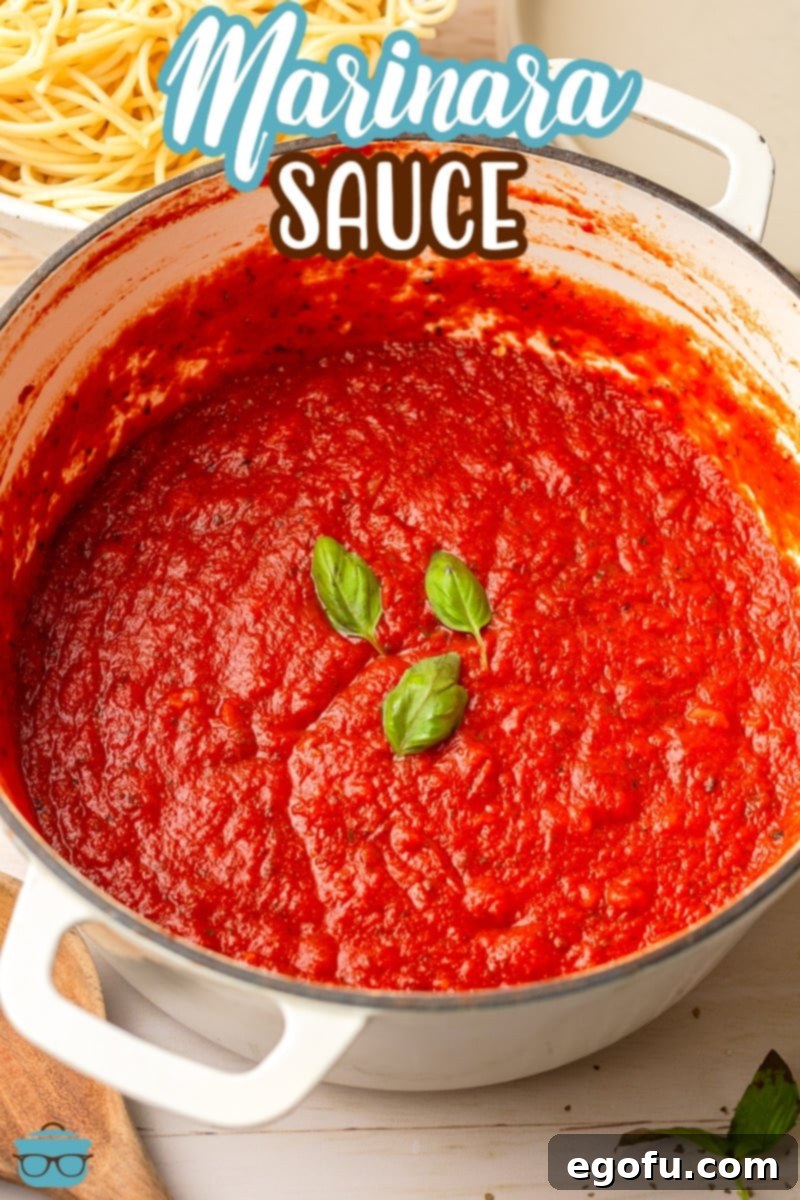
Essential Ingredients for Your Homemade Marinara
Crafting this delicious marinara sauce requires a handful of simple, high-quality ingredients. Each plays a crucial role in building the layered flavors that make this sauce so special:
- Olive Oil: The foundation of our sauce. Extra virgin olive oil will impart a richer flavor, but a good quality regular olive oil or even avocado oil works well for sautéing. It provides the medium for cooking our aromatics and helps to carry the flavors.
- Onion: Diced yellow or white onion, sautéed until soft and translucent, provides a subtle sweetness and depth. If you’re not a fan of onion chunks in your sauce, you can finely mince it or even grate it to make it virtually disappear into the sauce while still contributing flavor.
- Garlic: Fresh garlic is non-negotiable for the best flavor! Minced fresh garlic offers a pungent, aromatic punch that jarred garlic simply cannot replicate. Aim for 3-4 cloves, but feel free to add more if you’re a garlic lover. Just be careful not to burn it during sautéing, as burnt garlic turns bitter.
- Dried Basil: A classic Italian herb that brings a sweet, peppery aroma. Dried basil works wonderfully in a simmering sauce, as its flavors bloom and deepen over time. (Refer to the FAQ section above for substituting with fresh basil.)
- Dried Oregano: Another essential Italian herb, offering an earthy, slightly bitter, and robust flavor. Together with basil, it forms the aromatic backbone of this marinara.
- Crushed Red Pepper Flakes: (Optional) These add a subtle warmth and a gentle kick that enhances the overall flavor without making the sauce overtly spicy. Adjust the amount to your preference, or omit entirely if you prefer a completely mild sauce.
- Tomato Paste: This concentrated tomato product is a secret weapon for adding intense umami and a rich, deep tomato flavor. Sautéing it briefly with the aromatics helps to deepen its flavor, a technique known as “blooming.”
- Tomato Sauce: Provides the smooth, liquid base for the marinara. Choose a good quality canned tomato sauce for the best results.
- Crushed Tomatoes: These offer texture and a fresh tomato flavor. You can opt for plain crushed tomatoes or those with basil already added for an extra layer of herby goodness. The juice from the can is essential as it contributes to the liquid and flavor profile.
- Granulated Sugar: (Optional) A small amount of sugar helps to balance the natural acidity of the tomatoes, creating a well-rounded and harmonious flavor. If you’re looking for an alternative to sugar, remember the baking soda trick discussed in the FAQ section!
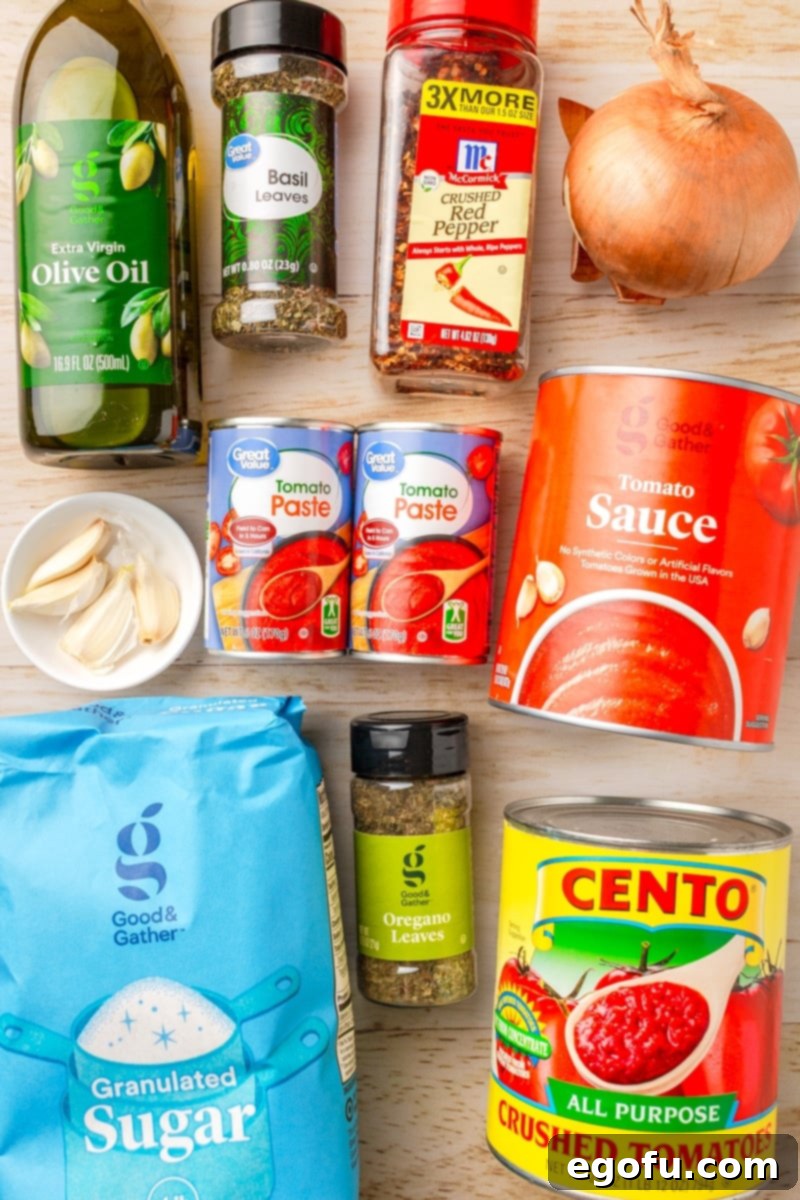
Step-by-Step Guide: How to Make Homemade Marinara Sauce
Follow these simple steps to create your own irresistible marinara sauce. The process is straightforward, requiring minimal fuss for maximum flavor payoff:
Sauté the Onions: In a large skillet, Dutch oven, or heavy-bottomed pot, heat 2 tablespoons of olive oil over medium heat. Add the diced yellow onion and sauté, stirring occasionally, for 4-5 minutes until the onion softens and becomes translucent. This step mellows the onion’s flavor and builds a savory base.

Bloom the Aromatics: Add the minced garlic, dried basil, dried oregano, and crushed red pepper flakes (if using) to the pot with the softened onions. Continue to sauté for just 1 minute longer. Be vigilant here: garlic can burn quickly, turning bitter. You want to cook it just until it becomes fragrant, releasing its pungent aroma into the oil and softening the dried herbs.

Incorporate Tomato Products: Stir in the 12-ounce can of tomato paste. Cook for an additional 1-2 minutes, stirring constantly, allowing the tomato paste to darken slightly and develop a richer flavor (this is the “blooming” of the paste). Then, add the 29-ounce can of tomato sauce and the 28-ounce can of crushed tomatoes, including all their juice. Stir everything together until well combined.

Simmer to Perfection: Bring the sauce to a gentle boil. Once boiling, reduce the heat to low, cover the pot with a lid, and let it simmer for at least 30 minutes. Stir occasionally to prevent the sauce from sticking to the bottom. For a deeper, more complex flavor, you can simmer for up to 1-2 hours, ensuring the heat remains low and you stir frequently.

Adjust Seasoning: After simmering, taste the sauce. This is your moment to fine-tune the flavors. If the sauce tastes a bit too acidic or tart, stir in 2 teaspoons of granulated sugar (or your preferred acidity balancer like baking soda, as discussed in the FAQ) until it achieves a harmonious balance. Add salt and black pepper to taste.
Final Stir and Serve: Give the sauce one last good stir to ensure all the flavors are evenly distributed. Your homemade marinara sauce is now ready to enjoy!
Serving Suggestions: Serve this luscious marinara sauce generously over your favorite pasta, use it as a flavorful dipping sauce for crusty garlic bread, or incorporate it into other recipes like homemade pizza or lasagna. The possibilities are endless!

Craving More Delicious Recipes?
If you loved this marinara sauce, you’re sure to enjoy these other comforting and flavorful dishes:
- Crock Pot Homemade Meatballs and Marinara
- Chicken Parmesan Casserole
- Crock Pot Beef Ragu
- Pizza Hut Garlic Cheese Bread
- Million Dollar Spaghetti
- Cowboy Spaghetti
- Meatball Sub Cups
- Homemade Meatballs
- Cheesy Garlic Bread

Homemade Marinara Sauce
Seasoned to perfection, this Homemade Marinara Sauce is a great recipe to use in all your favorite pasta dishes!
Rated 5 out of 5 stars by 6 reviewers.
Print Recipe |
Pin Recipe |
Rate this Recipe
Prep Time: 10 minutes | Cook Time: 40 minutes | Total Time: 50 minutes
Servings: 12 servings
Author: Brandie Skibinski
Ingredients
- 2 Tablespoons olive oil (or avocado oil)
- 1 small yellow onion, diced
- 3-4 cloves garlic, minced
- 2 teaspoons dried basil
- 2 teaspoons dried oregano
- ½ teaspoon crushed red pepper flakes (optional)
- 12 ounce can tomato paste
- 29 ounce can tomato sauce
- 28 ounce can crushed tomatoes
- 2 teaspoons granulated sugar (optional, helps with the acidity of the tomatoes)
Instructions
In a large skillet or Dutch oven, add 2 Tablespoons olive oil and sauté 1 small yellow onion, diced until soft and translucent (4-5 minutes).

Add 3-4 cloves garlic, minced, 2 teaspoons dried basil, 2 teaspoons dried oregano and ½ teaspoon crushed red pepper flakes until garlic is fragrant (about 30 seconds to one minute).

Add 12 ounce can tomato paste, 29 ounce can tomato sauce and 28 ounce can crushed tomatoes (juice included).

Bring to a boil. Reduce heat to a simmer, cover with a lid, and cook for 30 minutes, stirring occasionally.

Taste the sauce and add 2 teaspoons granulated sugar (or to taste) as needed to balance the acidity in the sauce.
Stir to combine.
Serve over pasta, as a dipping sauce for garlic bread, etc.

Notes
- Please refer to my FAQ’s (Frequently Asked Questions) and ingredient list above for other substitutions or for the answers to the most common questions.
Course: Sauce | Cuisine: Italian-American
Nutrition
Calories: 181kcal | Carbohydrates: 32g | Protein: 7g | Fat: 6g | Sodium: 1345mg | Fiber: 8g | Sugar: 21g
Nutritional Disclaimer
“The Country Cook” is not a dietician or nutritionist, and any nutritional information shared is an estimate. If calorie count and other nutritional values are important to you, we recommend running the ingredients through whichever online nutritional calculator you prefer. Calories and other nutritional values can vary quite a bit depending on which brands were used.
Did you make this recipe? Share it on Instagram @thecountrycook and mention us #thecountrycook!
